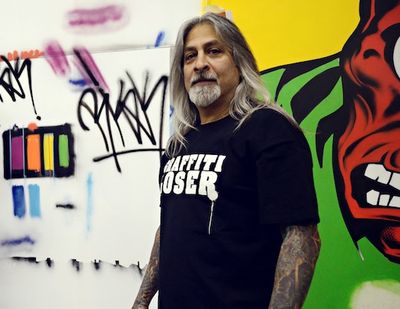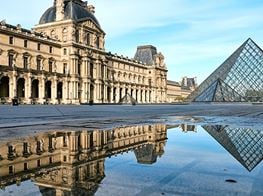Seen

Images of Richard "Richie" Mirando’s artwork are synonymous with the historical cityscape of New York. Born in the Bronx in 1961, and known as SEEN, he has become one of the most well known street artists and is often referred to as the Godfather of Graffiti. SEEN first started to paint on New York's subway in 1973, age 11. What began as a quick scrawl on the inside of a train over the next ten years developed into producing full-color masterpieces on whole train cars, which in turn contributed to some of the most iconic images of New York. The artist’s work then moved from the street to canvas and from trains to gallery walls, and he exhibited alongside artists such as Keith Haring
, Andy Warhol, and Jean-Michel Basquiat. SEEN also featured in the acclaimed 1983 documentary Style Wars, which explored hip-hop culture; and his vision became ingrained in popular culture with images of his work appearing in well-known digital video-games.
The exhibition, Post No Bills, which opened this month at Opera Gallery’s Hong Kong space, features large canvases upon which SEEN has rendered crisp cartoon superheroes against backgrounds that recall his early graffiti scrawl. Anna Dickie spoke to the artist about his journey from the street to gentrified gallery space, and his latest work.
Where did it all begin?
I was about 11 years old and walking distance from my house was the shopping area where my mum used to go grocery shopping and stuff. I used to walk to the Avenue with her. She didn’t drive back then. Once on the Avenue, you could see the elevated tracks and I would watch the trains go by and I would see the graffiti on the trains. Graffiti wasn’t all bright and colourful like it is today. There were just names scrolled on the outside of the train with spray paint. It was just a bunch of names and I had no clue what they said or what they meant. I knew nothing about what was going on. I was eleven years old! But the thing is – when I saw it – it was just something that I wanted to do. So one day I went to the Avenue by myself and I went up to the steps of the train station and I ran under the turnstile and I ran up the steps and I waited for the train to come by; and when it came by, I had a simple skinny little marker and I got on the train and I scrolled my name on the inside of the train and it was exciting. I got off at the next stop and I turned and I got on a train going back the other way, and I wrote my name on the inside of that train too. And then I ran off the train station.
Then I started to carry the same marker with me on my walk to school. My walk to school was like four blocks from my home and I would carry this marker with me and I would walk past objects and scribble my name on them – just standard objects. So I was going to school scribbling my name on the light box, the mailbox and all those sorts of things. I was scribbling my name going to school, leaving school – on the school doors and I also started doing doodles on the school desk. I was only 11 years old, but from there it kept on escalating.
When did the scribbles morph into painting trains?
I realized that the train yard was only a few blocks away from my home station so one day I went to the train yard with a couple of little tester pots - they were used to paint the model cars or aero planes. And I had these mini cans of paint and I went to attempt to paint the train yard. The first attempt didn’t work. I ended up painting the wall outside the train yard because something spooked me. But the next day I came back and I had two cans of paint that I bought from home – back then you used it to paint the patio furniture or the lawn mower or something like that – and I took the two cans and I went to the train yard with my brother. My brother is a year younger than me and it was broad daylight on a Saturday afternoon and we entered the train yard through a hole in the fence. Once inside I wrote my name on the outside of the train. It was the most exciting/ adrenalin rush I could describe. It made me want to do more and more and more. From that day on I started to paint once a week.
Would you be adding to work you had done before or finding new space?
I was always finding new space. Once a train had left the chances of seeing that train again were not high. I would just do another one and another one. But back then it was so primitive – so I would take one can of paint and do a fill in and then use the other can for the outline. The one that I used for the outline became my fill in and then the reverse – so you get two little – well back then they were called ‘masterpieces’, and then the name became ‘pieces’. But ‘Masterpieces’ was what it was called back in the seventies – what you called when you did a piece with a ‘fill in’.
How did you find your paint?
Back then you didn’t buy paint because you didn’t have money to buy paint but you had to get it somehow. Truth of the matter is that it was all stolen paint - so it all became about learning the techniques of how to ‘rack’ paint (which is stealing paint). I would go to the hardware store. I started off by putting two cans of paint near my stomach and maybe a can in my sock. Remember, I am a little kid now and your clothes aren’t that baggy back then. They were still tight other than bell-bottoms – which were loose at the bottom. You really had to be careful and try and get what you could. As I learnt how to get more and more paint and I started hitting more stores, I started to go painting more and more.
So adrenaline was very much part of the drive to paint – from the stealing to the actual spraying?
Yes, it was huge procedure from the beginning to the end: from getting your paint, to avoiding being caught by the police, the train not pulling out on you and actually getting the painting done. The next day you had to wait on the station to get your picture taken.
It was important than to always record the work via a photograph?
Yes, that was a big deal. I was lucky actually to get a photograph of the very first piece I did on the train, but I didn’t get it until about a year or so later. By accident I was sitting waiting for a train - and I was almost 13 years old – and I am sitting there waiting for a train – and pieces on trains don’t usually last that long – the city would scrub them about once a year, but sometimes they would make it through the buff. But one day I am sitting at the station on the train and the doors open and right across from me was the first piece I ever did. I had a camera on me and I just snapped the picture right there and then. That was the only time I ever saw it. That is how I got a picture of my first piece, and it was from 1973.
Although you were generally doing the graffiti by yourself, you were obviously becoming part of a community of people because you speak in what appears to be a shared language – piece, masterpiece, racking, buff?
Yes – but for me it was still very much an individual experience. Not so far from me there was a YMCA – where you could play gym and basketball. It was a place for kids so I was going there for a bit and I was meeting other people there. There I started to learn the language and all, but I kind of still stuck to myself because these people were painting elsewhere. I had my spot where I liked to go and I felt comfortable. I would sit on this little wall and I would wait for the train to roll in and then when the worker/ the motorman would leave, I would just jump down and paint my train and I would be happy. I did it years like that.
In later years it became more of hangout thing. I used to hang around with my brother and cousins and my neighborhood friends. Even when we had girlfriends, the girlfriends would hang out there and everyone would play in the train yard like it was a playground. It was fun. Instead of going to the park, we went to the train yard and hung out.
Then later on I started to venture out and go a little bit further to different train lines. That was when I started to meet people here and there but still you wanted to stay to yourself. Back then everyone was on an ego trip. It was about who was better than whom. You had to worry about whom you were going to get into a fight with.
Was it very territorial?
Yeah. You had to fight for your space, your paint – particularly if someone tried to rob your paint you know. Back in the seventies there were a lot of street gangs so you had to be careful which neighborhoods you went into and you had to be careful going into certain areas that you didn’t belong because you could find yourself in a little bit of a predicament. It was tough back then. I was still in my early teens doing all that. I found myself in places where I didn’t even know where I was. I would get lost on the train and would have no idea how to get home – but by the end of the day, I would find my way home. Half the time I didn’t realize I was lost until suddenly I realized I had to be home for dinner.
How did you move from painting in the street to showing canvas works within a white gallery space?
I think the move from street to gallery was easier for me than for others. Me - I was always painting - not just the trains. When I grew up I always had paper, crayons, markers, canvas. I was painting canvas in the mid 1970s for myself and I wasn’t doing graffiti on it. In 1979 and 1980 I was showing work in the galleries. I was doing both graffiti on the street and I was in the galleries at the same time – I had two worlds going on. For a lot of people who come from the street it became more of a new thing for them - but I was doing it all at the same time. So I don’t feel too worried about it. The only thing is that when I started to put the graffiti work onto canvas at the beginning it didn’t transcend very well from the street to the canvas – this was because I was just peeling off what I did on the train and pasting it onto the canvas. To me it didn’t feel right. It didn’t look right. I wasn’t comfortable with that. It took a lot of years for me to figure it out so I was satisfied. So I went through a whole period of time when I was working this out. Sometimes it was a gamble – I destroyed a lot of canvases along the way. Now I think I have figured out what I am happy with. But now it comes too easy. Sometimes I miss the fight. There was a fight to getting good – it was the same when I started to paint the trains. At the start I wasn’t that good at it, but at some point I mastered what I was trying to do on the trains.
But then I was in another predicament – I don’t like to stay still in one area. I paint these superhero works, then next week I do abstract. I mix it all up. I am going to call myself a machine because I am a workaholic. I work seven days a week. I get up at 9 in the morning and then I am at the studio until 3 or 4 in the morning. I am working, I am painting and if I get tired or bored or I draw a block then all of a sudden I find myself doing another body or style of work in a whole other way.
You get defined as a graffiti artists, but really you are an artist who has being exploring paint and the medium you paint on – you have done trains, you have done canvas, I can see by your tattoos you have done skin. Would that be a valid conclusion?
I need to keep on exploring because I get bored real fast. I have to change. I keep on flipping. I did five years in Paris. When I was there I didn’t paint any graffiti based work except when I needed to pay my bills. At the end of the month I would sell some graffiti work to pay my bills. I did five years of solely exploring different abstract areas and painted so many paintings in that area. I needed to explore that. I was bored with just doing the graffiti. I needed something to refresh myself. Once I tackle something I have to move on. Don’t get me wrong I will come back once I feel the energy again.
Here is the problem – the problem is that I do so much different work that my work isn’t recognizable because I am all over the place. You get some artists – Keith Haring for instance – you can see his work from across the road and you know it is his work - right? I thought that is what I wanted. But the truth is what happens then? You get stuck. You cannot expand or grow. We don’t know what would have happened with Haring because he passed away, but the point is I don’t think I will have work that is recognizable across the road because I am into so many different areas and I am happy that way. It is what I need.
Tell me about the Superhero Series? Is this a revisiting of your childhood?
This isn’t a re-visiting – I have spent my life looking at that. I love cartoons. I am the product of television and it is nothing but cartoons and comic books for me. It is not a re-visit. It has never left me.
How are the works created – explain the use of stencil verse freehand?
It is with a stencil, but I am not cutting out a cardboard stencil and then spraying them on otherwise I would have too many breaks. There are no breaks in the outlines. I am trying to capture a solid, clean stamp, like coming out of a comic book. That is why the image is so perfect - so clean and crisp. The background I try to keep soft – a more graffiti feel. With each one I am actually laying heavy thick pieces of tape across the canvas. If I do Dick Tracy for example, I have to do six separate cuts – so each one has its own stencil. Each one isn’t identical. I am hand cutting each one and making it to size. It’s kind of a time consuming thing, but I like the final effect. Sometimes I feel it takes me away from being a little more free with my work and it just coming out of me. I lose some free movement. But I think I still capture that when I work with my background.
What are you working on now?
I am still working on the Superhero series. They are so many different ways I want to go about this. I don’t see it ending anytime soon in terms of me getting bored with it. I have already ordered new canvas for when I get back. I will be cutting them up and putting them on the walls. The works are going to be more raw and not as clean and crisp. I want to turn more to collages and start layering them to give them some depth. I want to give them more of a street feel. I want you to actually feel like you are walking down the street and you could be looking at a wall. I haven’t done it yet and I cannot explain it now. The Opera does have one piece that I tapped the surface of what I want to do – the Silver Surfer work – the images are becoming ghostly.
So, like the memory of seeing a work?
Yeah that could work. I’ll throw you a bone on that one.
Image courtesy of Olivia de la Borie













































































































































































